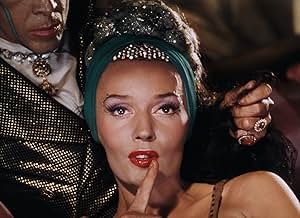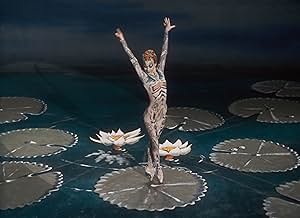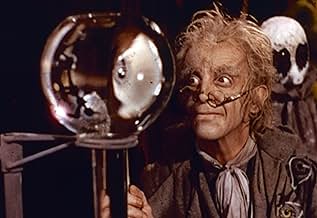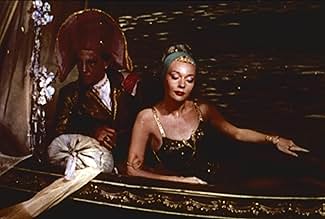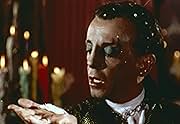Ein melancholischer Dichter denkt über drei Frauen nach, die er einst geliebt, aber verloren hat: eine mechanische Puppe, eine venezianische Kurtisane und die anstrengende Tochter eines gefe... Alles lesenEin melancholischer Dichter denkt über drei Frauen nach, die er einst geliebt, aber verloren hat: eine mechanische Puppe, eine venezianische Kurtisane und die anstrengende Tochter eines gefeierten Komponisten.Ein melancholischer Dichter denkt über drei Frauen nach, die er einst geliebt, aber verloren hat: eine mechanische Puppe, eine venezianische Kurtisane und die anstrengende Tochter eines gefeierten Komponisten.
- Für 2 Oscars nominiert
- 2 Gewinne & 3 Nominierungen insgesamt
- Giulietta
- (as Ludmilla Tcherina)
- …
- Spalanzani
- (as Leonide Massine)
- …
- Olympia
- (Gesang)
- …
- Giulietta
- (Gesang)
- …
- Nicklaus
- (Gesang)
- …
- Antonia's Mother
- (Gesang)
- Spalanzani
- (Gesang)
- …
Empfohlene Bewertungen
The story begins in Nuremberg as Hoffmann watches the object of his affections, Stella (Moira Shearer) dance a ballet. During the intermission, he goes into a tavern and tells the customers about his three major affairs.
Opera singers, with two exceptions, dub the stars, who are mostly from the ballet world; several will be familiar from The Red Shoes: Moira Shearer, Ludmilla Tcherina, Robert Helpmann, Léonide Massine, and Frederick Ashton. Only Hoffmann, Robert Rounsville, and Antonia, Anne Ayars, do their own singing. The rest of the vocals are provided by Dorothy Bond, Margherita Grandi, Monica Sinclair, Joan Alexander, Grahame Clifford, Bruce Dargavel, Murray Dickie, Owen Brannigan, Fisher Morgan, and Rene Soames.
Both the singing and dancing are absolutely magnificent, the beautiful Shearer dancing much better than she did in The Red Shoes several years earlier, and Powell and Pressburger fill the opera with fantastic effects and colors. My favorite is Shearer's doll ballet sequence, with the glorious coloratura singing of the Doll Aria by Dorothy Bond, a discovery of Sir Thomas Beecham, who conducts the orchestra. Tragically she was killed in a car accident the next year; she deserved to be one of the most famous sopranos who ever lived.
There are a couple of problems with this incredible piece. It's done in English, which due to the tamber of the high soprano voice, can make it difficult to understand. So people who know the opera would probably enjoy it the most. Secondly, it's not paced very well - there are some very draggy sections; some of the chorus work could have been cut.
The overall effect for the eyes and ears is fabulous, but "The Tales of Hoffmann" leaves one depressed for how far we've fallen culturally in this world. Imagine mounting this film today. How many people would attend? Five?
In the story a poet Hoffman tells in episodic fashion about the many times that he has loved and lost. There have been several films made with such a theme but Hoffman stands well apart because of the Goth-fantastic nature of the narratives. Hoffman, in turn, falls in love with Olympia - a puppet, Guiletta - the temptress of a soul-stealing demon, and Antonia - a singer doomed by fatal consumptive illness.
This narrative is complemented by the brilliantly supportive artistic design of the film. The makers construct a deliberate stage-like ambiance, with the use of representative backdrops, suitably exaggerated props and striking motifs to convey the settings and moods of the various episodes. In this aspect it shares strong kinship with Masaki Kobayashi's period ghost story anthology Kwaidan. You also have the concept of the same actor returning to play different parts in the various episodes of Hoffman's life, the most notable of which is Robert Helpmann who portrays the sinister element in all the episodes (and with his vampiric menacing look, does a terrific job of it, although his motive for evil in the Antonia episode goes unexplained).
The fantastic elements of the plot, color-drenched distinctive look, intricate balletic choreography and excellent fit of all the actors in their roles make Tales of Hoffman a very interesting watching experience on the whole.
One of my caveats with the film is that Hoffman's companion Nicklaus is never properly explained. Who is this woman in man's garb and why is she doing what she does?
On first viewing, my reaction to it was mixed: it's impossible not to be impressed by the visuals (particularly the stylization of Hein Heckroth's colorful and imaginative designs) but, since I'm no expert in classical music, I wasn't bowled over by Jacques Offenbach's score (apart from the celebrated "Barcarolle" piece) - especially since the lyrics, despite being an English translation, aren't easily followed! However, listening to it with the Audio Commentary, I could better appreciate the way it was made and the special effects that were adopted; especially interesting was the fact that it was filmed silent, thus allowing freer camera movement. The main cast, apart from Pamela Brown, is made up of ballet performers and opera singers - with the former, mostly recruits from THE RED SHOES, carrying the more compelling screen presence.
The framing story - featuring an additional ballet composed by the film's conductor Sir Thomas Beecham - is a bit short, so that we mostly learn about the characters played by Robert Rounseville (as Hoffmann) and Robert Helpmann through their various guises in the former's three tales (which are themselves variable in quality):
i) the "Olympia" sequence, highlighting Moira Shearer and Leonide Massine, is overlong but quite charming; Helpmann's distinctive features are rather buried under some quaint make-up - though his violent destruction of Shearer (who plays a doll) makes for a quite unsettling moment!
ii) "Giulietta" is the best and most interesting sequence, but also the shortest: Ludmilla Tcherina is a very sensuous heroine, while Helpmann and Massine are wonderful (and wonderfully made up) as respectively an evil magician and a (literally) soulless officer under both their spell; this sequence features some incredible imagery - like Tcherina's reflection in water picking up the aria she is singing, her walking over sculptures of dead bodies, Rounseville and Massine's saber duel set to music (i.e. presented without any sound effects) and the scene in which Rounseville loses his reflection when tempted in front of a mirror by Tcherina
iii) the "Antonia" sequence is again too long (it was severely cut in the original U.S. theatrical release) and, because it's mostly straight opera, emerges as the most labored segment: Massine is pretty much wasted here, while Ann Ayars is nowhere near as captivating as Shearer or Tcherina; however, Helpmann's belated entrance as the satanic Dr. Miracle takes the sequence to another level, and especially memorable here is the scene where Ayars exits a room only to re-enter it from another door (which must have inspired a similar incident in Mario Bava's KILL, BABY, KILL! [1966]) and the one where Ayars and Helpmann's dancing figures are divided into four to fill up the entire screen - with the latter taking each of his guises in the different segments and, likewise, the former being replaced with the heroines of each tale (Moira Shearer appears twice here as she also plays Stella, Hoffmann's love interest in the framing story!)
The Archers' films are among my favorites - though I was somewhat underwhelmed by I KNOW WHERE I'M GOING! (1945; I still haven't purchased the Criterion SE), THE BATTLE OF THE RIVER PLATE (1956; amazingly, both of my two attempts to view it in the past have only managed to put me to sleep!) and, now, THE TALES OF HOFFMANN. I've yet to watch 4 of their collaborations - CONTRABAND (1940; I've been tempted, time and again, to buy Kino's bare-bones DVD but the over-inflated price always got in the way!), THE ELUSIVE PIMPERNEL (1950), GONE TO EARTH (1950; this troubled production isn't likely to see the light of day on R1 DVD anytime soon, but is at least available via a budget-priced R2 edition), and their last 'musical' together OH, ROSALINDA! (1955). I would also like to watch Powell's solo films HONEYMOON (1959) and BLUEBEARD'S CASTLE (1964), which are yet two more musically-oriented ventures.
Wusstest du schon
- WissenswertesGeorge A. Romero, writer/director of Die Nacht der lebenden Toten (1968) and Zombie (1978) has cited this as his all-time favorite movie, saying that it was the one that originally inspired him to get into filmmaking.
- PatzerGiulietta's necklace is turned from jewels to wax by Dapertutto, however, in a longer shot, it is briefly shown as jewels again, before a close-up, where it is wax again until Dapertutto changes it back to jewels.
- Zitate
Chorus of Students: Some drink, drink, drink, drink, drink: do you hear us about? You lazy lout! We want some beer; we want some wine! Pour out the wine, and drink and drink till morning. Pour out the wine for drinking is divine. It is divine. We want some beer; we want some wine. We want some beer; we want some wine.
- Crazy CreditsIn the end credits, main actors appear taking curtain calls next to the singers who dubbed them.
- Alternative VersionenThe complete 138-minute version was available in 16mm black and white early television prints. The complete 138-minute version was also available in 16mm Kodachrome (color) rental prints. The complete 138-minute soundtrack was available for many years on LP (London Records).
- VerbindungenFeatured in The Late Show: Michael Powell (1992)
- SoundtracksThe Tales of Hoffmann, A Fantastic Opera
Music by Jacques Offenbach
Arranged by Thomas Beecham (uncredited)
English libretto by Dennis Arundell
From the French text by Jules Barbier
Conductor: Thomas Beecham (as Sir Thomas Beecham Bart.) with The Royal Philharmonic Orchestra
Sung by Robert Rounseville, Dorothy Bond, Margherita Grandi, Ann Ayars (as Ann Ayars), Monica Sinclair, Joan Alexander, Grahame Clifford, Bruce Dargavel, Murray Dickie, Owen Brannigan, Fisher Morgan, Rene Soames, and The Sadler's Wells Chorus
Top-Auswahl
Details
- Erscheinungsdatum
- Herkunftsland
- Sprache
- Auch bekannt als
- Los cuentos de Hoffman
- Drehorte
- Produktionsfirmen
- Weitere beteiligte Unternehmen bei IMDbPro anzeigen
Box Office
- Bruttoertrag in den USA und Kanada
- 91.930 $
- Eröffnungswochenende in den USA und in Kanada
- 23.340 $
- 15. März 2015
- Weltweiter Bruttoertrag
- 140.714 $
- Laufzeit
- 2 Std. 13 Min.(133 min)
- Seitenverhältnis
- 1.37 : 1




